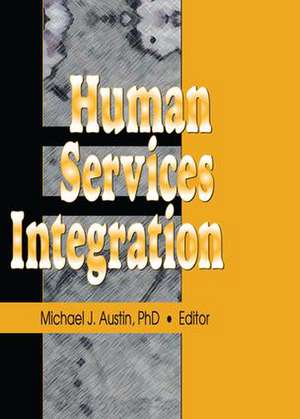Human Services Integration
Autor Michael J. Austinen Limba Engleză Paperback – 6 oct 2016
Human Services Integration covers practice principles for managing organizational and community change and offers strategies for organizing human service agencies and overcoming fragmented service integration in communities with complex problems and needs. To also help you identify specific service intergration activities that are relevant in the context of unique communities, it discusses:
- specifications for conducting a self-assessment of progress at the local level toward social service integration goals
- Georgia’s Family Connection, a statewide human services initiative
- interweaving formal and informal systems of care in a community-centered approach to service integration
- a children’s initiative collaborative
- social science theory pertinent to service integration
- gathering support from elected officials such as boards of supervisors, city leaders, and local elected boards
Human Services Integration will help you understand why service integration cannot be defined by a particular service model or outcome. Its insight will also help you understand why involving service users and community members in the design and delivery of services is fundamental to developing an integrated service system that is culturally competent, empowering, and responsive to its neighborhood and community context.
Preț: 482.35 lei
Nou
Puncte Express: 724
Preț estimativ în valută:
92.30€ • 96.61$ • 76.82£
92.30€ • 96.61$ • 76.82£
Carte tipărită la comandă
Livrare economică 31 martie-14 aprilie
Preluare comenzi: 021 569.72.76
Specificații
ISBN-13: 9781138972124
ISBN-10: 1138972126
Pagini: 186
Dimensiuni: 152 x 229 x 10 mm
Greutate: 0.45 kg
Ediția:1
Editura: Taylor & Francis
Colecția Routledge
Locul publicării:Oxford, United Kingdom
ISBN-10: 1138972126
Pagini: 186
Dimensiuni: 152 x 229 x 10 mm
Greutate: 0.45 kg
Ediția:1
Editura: Taylor & Francis
Colecția Routledge
Locul publicării:Oxford, United Kingdom
Cuprins
ContentsService Integration: Introduction
- Service Integration: Something Old and Something New
- Marking Progress Toward Service Integration: Learning to Use Evaluation to Overcome Barriers
- Reclaiming Community: An Integration Approach
- Collaboration: A Study of a Children’s Initiative
- Launching a Family-Centered, Neighborhood-Based Human Services System: Lessons from Working the Hallways and Street Corners
- Assessing a Family-Centered Neighborhood Service Agency: The Del Paso Heights Model
- Applications of Boundary Theory to the Concept of Service Integration in the Human Services
- Index
Notă biografică
Michael J. Austin, PhD, ACSW, is Professor in the School of Social Welfare at the University of California at Berkeley. The former Dean of the University of Pennsylvania School of Social Work, he teaches graduate students in the area of administration and community planning. During the last 25 years, he has also taught at Florida State University and the University of Washington. Prior to beginning his academic career, he served as a management consultant for the National Institute of Mental Health and as a planner for United Way Planning Agencies in California. He also served as a management consultant to the Philadelphia Department of Human Services, the Florida Department of Health and Rehabilitation Services, and numerous other local, state, and national agencies. Currently, he serves as a consultant to the Bay Area Social Services Consortium, a twelve county and four university partnership related to policy, research, and training. He is the author of three books related to child welfare: Supervisory Management for the Human Services (Prentice Hall), Managing Staff Development Programs in Human Service Agencies (Nelson-Hall), and Managing Human Service Personnel (Sage). He has also written 12 books in the area of human service administration and 40 professional articles.
Descriere
Addressing the multiple meanings of service integration, Human Services Integration analyzes how motivations and expectations for social service integration differ significantly among different players in the service system. In a period of major budget cutbacks and welfare reform, however, it is important that service providers collaborate to reduce or eliminate boundaries between categorically defined and provided services. This book tells you about the efforts being made to provide existing services more efficiently while avoiding duplication and waste. As you will quickly see, developing consensus for service integration efforts at the administrative, community, and staff levels will result in the ability to set achievable goals and objectives and secure cooperation at all levels.
